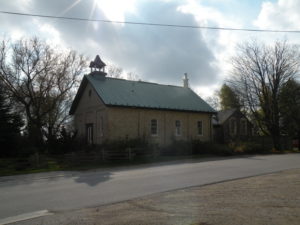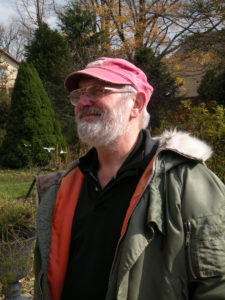A Citroën Parts Rescue Fable
– by George Dyke
Once upon a time in Ontario there were doughty bands of Citroëns running about the verdant countryside and the grimy cities. They were imported by Citroën Canada and sold by local Citroën dealers who struggled valiantly (no relation to Chrysler) to service them when something went awry. Were disaster to befall our beloved Citroëns, the car was discarded in favor of other Citroëns that still worked, or deserted for some other make (like a Volvo) that wouldn’t be such a hassle to maintain.
As time passed, snowy, slippery winters, held at bay by mountains of road salt, meant that most Citroëns that were daily drivers became afflicted by the highly infectious Orange Plague. It swept through the vast majority of Citroëns, leaving many owners to experience a mustiness inside as carpets became blotters, absorbing huge quantities of salty water from floors that were rapidly disintegrating or an inability of the car to rise on startup. Hence many Citroëns lay dormant on the road ill fated fodder for the junk yards. As time passed, Citroën Corporation chose not to heed rules of the land imposed from on high by Transport Canada. For practical reasons they folded operations, and fled in the night thereby orphaning the cars that were here.
As Citroën withdrew from Canada, a few hearty Citroën owners, notably Glen Fryer and Dave Kane, – advanced on many who had abandoned their cars in their driveways or on the highways of this fair land. They got them for free or at the most paid a few hundred dollars, hauling them to a land of promises; Dave Kane’s farm, located on Canada’s longest street; Yonge Street in the hamlet of Aurora. There they accumulated faster and more plentiful than hay bales.
But one day, about 15 years ago, Dave got a notice that the farm was sold to a housing development corporation. One of those nasty companies who cast their Toronto tentacles into the countryside and spread the plague of development into the pristine Oak Ridges moraine. It was time for Dave to move and the cars to go. And so they disappeared to a land known as Tottenham, and over time drifted to the hills of Uxbridge, where Dave tried hauling mostly complete cars, eventually to spend many hours carving them up into parts that could be put away somewhere. But where? By now rusty old Citroëns, even Citroën parts, were not welcome in Club members’ homes or garages. Citroëns were weird and discarded items. Few loved them. Fewer still owned one.
However there was one princely fellow named Freddie Fiex, living in an old schoolhouse just north of Arthur, whom Dave and Glen knew well. They called Freddie and asked if he wouldn’t mind housing a few parts that they’d drop off. Freddie said OK, they could put the parts in his basement for safe keeping. From that moment on, the basement of the school and the garden became a graveyard to about a dozen cars.
Freddie Fiex and his Schoolhouse home in Kenilworth.
Click on the above photos or here to view the full photo gallery.
As time went by, Freddie became increasingly weary of the all the Citroën stuff. So much so that in the summer of the year 2011 he called Glen and said that at least the parts inside needed to go to make space for a rec room he always longed for. Glen thought of what to do. All his garages were packed to the rafters, and one was recently demolished with another stash of Citroën stuff inside. Safe refuge was diminishing yet a whole load of parts long forgotten, had resurfaced. Clearly it was time to contact the Citroën Autoclub Canada. A Citroën salvation was needed! Club members could help in removing all things Citroën from Freddie’s save for his little 2CV buried under a woodpile in the back of his garage.
And so it came to be that on October 30, 2011, CAC members Bernard Laborde, Al Eberhard, John West and I stood in awe among a huge stash of Citroën parts squirrelled away in Freddie’s basement. We were there for a survey. To see the extent of what needed to be moved. Freddie said there were also interior seats in the attic and whole DS front ends in the yard outside. He offered to donate it all to the Club. An appreciated gesture to be sure, but when do we move it and where do we put them after Freddie’s?
Through the magic of modern email, I cast a call to action among our members. We determined that it was imperative we have at least 12 people to make the move efficient. Sietse Elsinga came forth to decree that we could store what we take in an out building on his estate (OK a dry space in the loft of his barn) near Grimsby. Others responded saying they’d be pleased to pitch in helping with the move and a few had trailers they were happy to provide. Looking at the weather forecast, and wanting to do the move before winter weather set in, we decided that Sunday November 6 would be the day.
We arrived at 11:00 am. And fortunately 15 members came forth to lend a hand. A merry band indeed, ready to rid the schoolhouse of the plague of Citroën. Al, Freddie and I started in the attic extracting 5 sets of seats that had been stuffed up there. Victor Alksnis, Jeff Teerlinck, John Long and Sietse went below and began passing out the parts though a basement window large enough that it permitted us to pass the parts outside. From there a brigade of members humped parts through the backyard to the driveway. Hump and hump we did. Fender after fender, door after door. Boxes and boxes of parts. In the driveway area, a triage was made of what to keep (and put in the trailer) and what to discard into the disposal bin that Freddie had arranged. A noble effort, made by all, resulted in getting everything sorted and loaded in under 3.5 hours. But one dumpster hath not the capacity for all discarded. Hence we made three piles in the driveway (seats, tires and more metal junk) for Freddie to load the next day when new bins cometh.
We trekked south that evening to Sietse’s farm in Grimsby, unloading what we amassed on our crusade that day. By 8 pm all the parts were tucked away in the nice dry loft of his barn. A new resource for Citroën Autoclub Canada members to utilize in the quest for eternal life of their D’s.
Now, with basement clear and attic emptied, Freddie can venture forth with renovation plans, while DS carcasses still lie strewn in the backyard behind the fence in what still remains to be a Citroën graveyard. Hoods lie atop the mounds of DS power trains, decapitated at windshield bases and severed behind each firewall, how they have come to be we know not why. Fire? Mechanical expiration? The injection of wrong hydraulic fluid? Now they lie with nature; Ashes to ashes, rust to rust… A field to which we will return in springtime of some future year, on a crusade to resurrect engines that remain unsiezed, and commencing yet another chapter in the book of Citroën Autoclub Canada’s Great Rescue Adventures.


